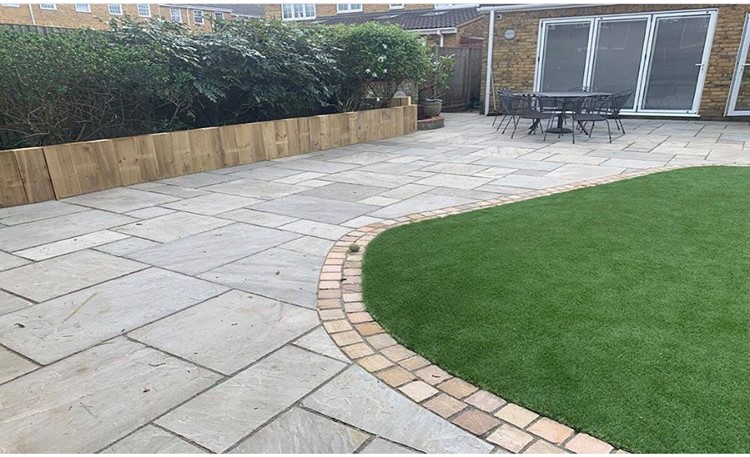Sandstone paving is a widely admired choice for outdoor spaces, appreciated for its natural beauty and versatility. However, a common question that arises is whether sandstone paving becomes slippery when wet. The short answer is yes, it can be slippery but it depends on the surface finish and the paving’s maintenance routine.
Factors That Affect Slipperiness
1. Surface Texture
- Riven or Textured Sandstone: Sandstone with a riven (textured) finish offers better traction, even in wet conditions. The natural unevenness of the stone helps to minimize slips by increasing friction underfoot.
- Honed or Polished Sandstone: These surfaces are smooth, offering little grip. When wet, honed or polished sandstone can become particularly slippery, and may not be suitable for high-traffic areas prone to moisture without additional treatment.
2. Porosity and Maintenance
Sandstone is naturally porous, which means it can absorb water, making the surface slick if not properly maintained. Over time, this porosity can lead to the growth of moss, algae, or other organic materials, which increase slipperiness. Regular cleaning and sealing can prevent this by reducing water absorption and deterring organic buildup.
3. Weather Conditions
In regions with high humidity or frequent rain, sandstone paving is more likely to become slippery. Opting for a textured finish or applying non-slip treatments can help in such environments. Also, proper drainage around the paving area can significantly reduce water pooling, further enhancing slip resistance.
How to Reduce Slipperiness
1. Choose the Right Finish
For outdoor areas exposed to moisture, opt for sandstone with a textured or riven finish. These provide natural traction, making them ideal for patios, pathways, and pool surrounds.
2. Apply Sealants
Sealants are a great way to protect sandstone from moisture absorption while also improving its slip resistance. Look for sealants specifically designed for natural stone, which not only prevent stains but also reduce slipperiness by sealing the pores of the stone.
3. Regular Maintenance
Keeping your sandstone paving free from moss, algae, and debris is crucial to maintaining slip resistance. Regular sweeping and occasional pressure washing can help maintain a clean and safe surface.
4. Consider Non-Slip Treatments
For areas with smoother finishes, consider applying a non-slip treatment or coating. These products increase the friction of the surface without altering the natural beauty of the stone.
5. Ensure Proper Drainage
Proper drainage is key to preventing water from accumulating on the surface, which can lead to increased slipperiness. Design your outdoor space to allow water to run off efficiently, keeping the paving dry and safe.
Conclusion
In summary, sandstone paving can become slippery when wet, particularly if it has a smooth finish or lacks proper maintenance. However, by choosing a textured finish, applying sealants, and keeping the paving clean, you can significantly reduce the risk of slips. For areas frequently exposed to water, using a non-slip treatment or opting for riven sandstone is recommended to enjoy the beauty of sandstone without compromising on safety.
References:
- Paving Stones Direct UK. “Riven vs. Honed Sandstone.”
- Stone Paving UK. “How to Maintain Sandstone Paving.”
- Paving Shopper. “Porosity and Cleaning of Sandstone.”
- The Stone Mart. “Why Apply Sealants to Stone Paving?”
- SmartSeal UK. “Sealants for Sandstone: Do They Improve Safety?”
- Sealer-Seal UK. “Slip Resistance in Natural Stones.”

